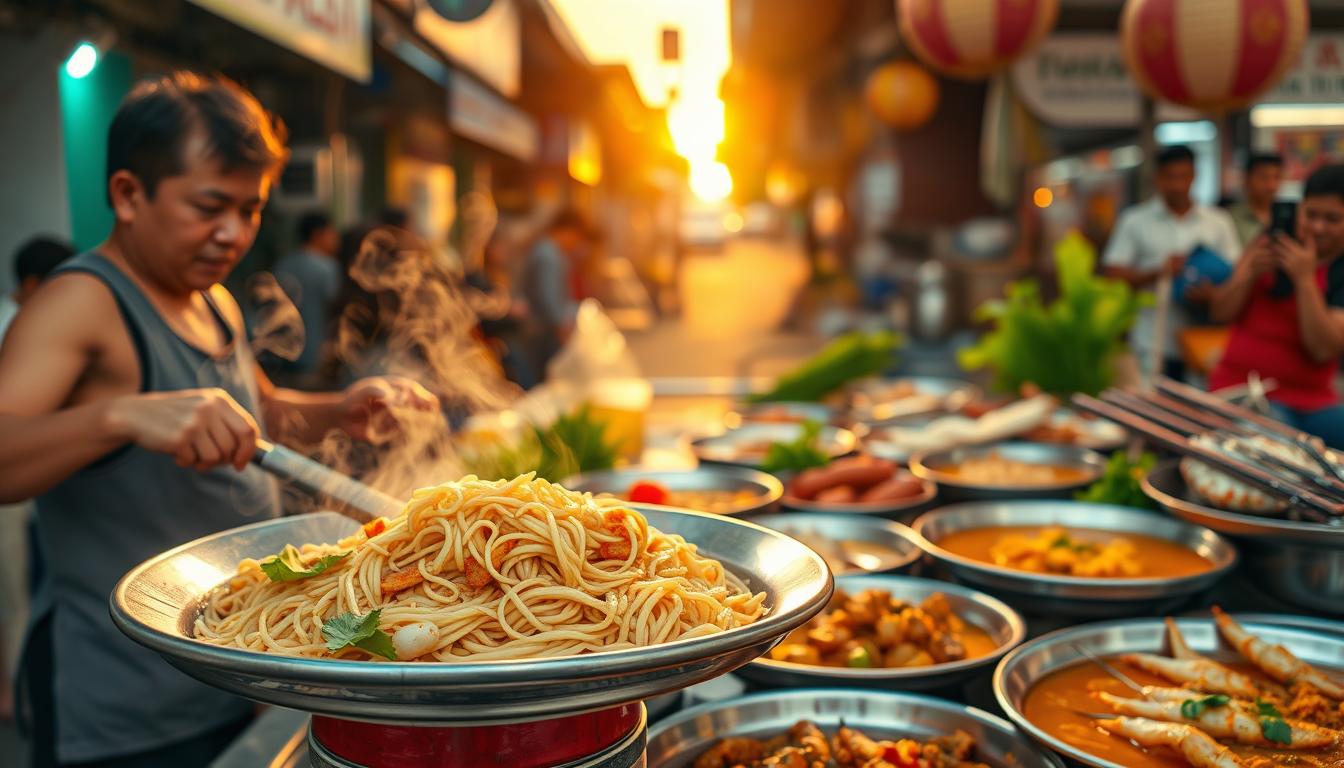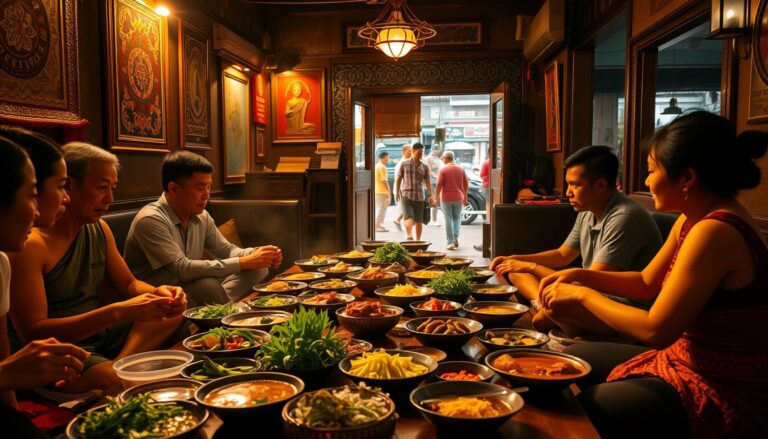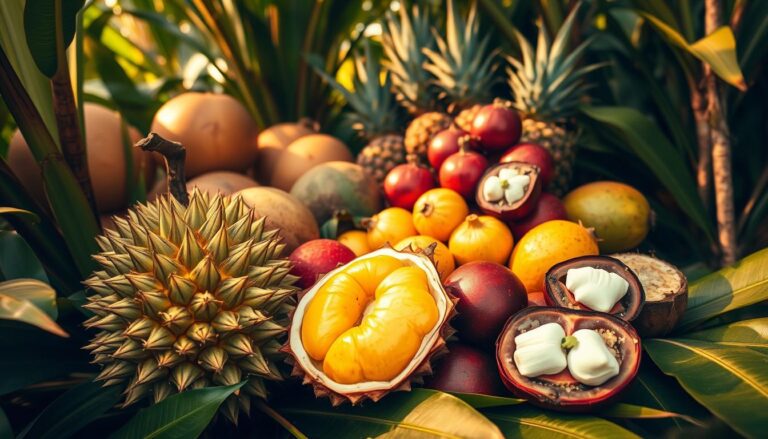Thailand’s Regional Food: A Foodie’s Guide
Did you know Thai cuisine is loved worldwide for its rich history and bold flavours? As you explore Thailand, get ready for a culinary adventure. Thai cuisine is famous for its bold flavours and spices, making every region a unique experience.
Bangkok’s busy streets and Chiang Mai’s peaceful hills each have their own special dishes. You’ll discover must-try foods, cooking methods, and cultural events. As a food lover, you’ll find Thailand’s culinary traditions both varied and rich.
Introduction to Thai Cuisine
Starting your journey through Thailand’s food scene is exciting. Thai food is more than just eating; it’s a mix of culture, history, and everyday life. It combines flavors and cooking methods from many places, shaped over centuries.
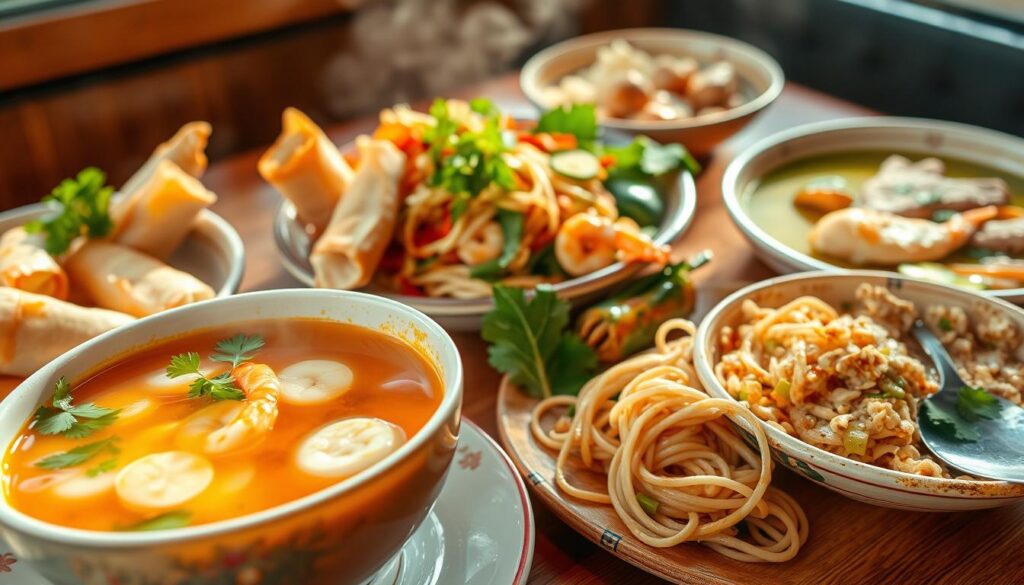
The Diversity of Thai Regional Dishes
Thailand’s food world is full of different tastes. The northeast is famous for som tam (green papaya salad), while the south is known for its fragrant curries. The north offers khao soi, a tasty noodle soup, and Bangkok is a street food paradise.
Bangkok is a top spot for street food lovers. You’ll find pad thai and tom yum soup everywhere. It shows how rich and varied Thai food is.
Why You Should Explore Thai Food
Trying Thai food is more than just eating. It’s about diving into the culture and history of each dish. Thai food balances sweet, sour, salty, and spicy flavors, making it a thrilling culinary adventure.
- Discover the unique flavors of each region.
- Experience the street food culture in cities like Bangkok.
- Learn about the traditional cooking techniques and ingredients used in Thai cuisine.
Exploring Thai cuisine lets you enjoy tasty meals and learn about Thailand’s culture and traditions.
Northern Thailand: A Taste of the Highlands
Northern Thailand is a food lover’s paradise. Its cooler climate and fertile soil make it ideal for growing crops. Tea, coffee, and herbs are key to its cuisine.
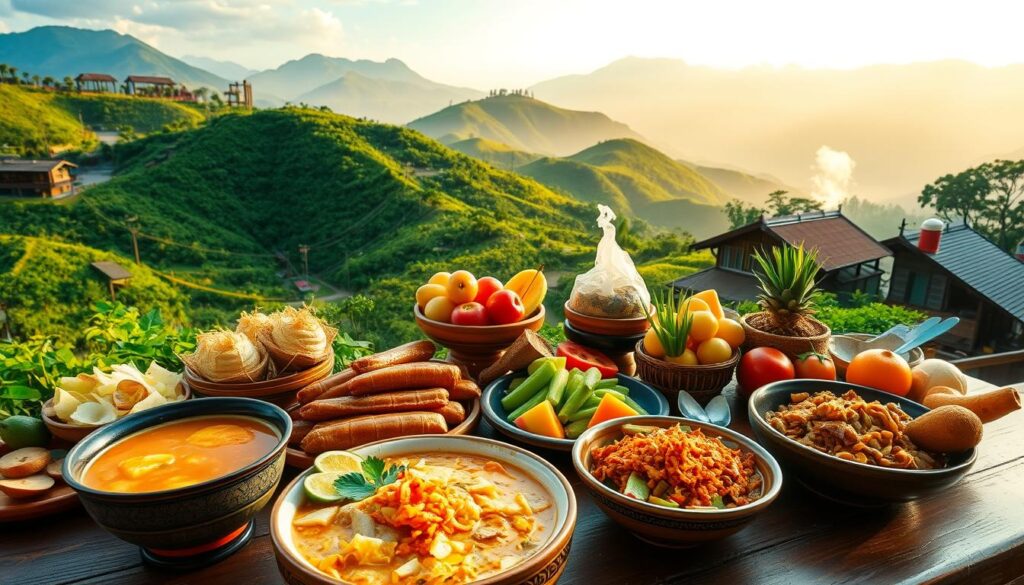
Signature Dishes You Must Try
Northern Thailand is famous for its regional delicacies. Try Khao Soi, a curried noodle soup that’s both comforting and rich. Don’t miss Sai Oua, or Chiang Mai sausage, made with pork, herbs, and spices, served with sticky rice.
- Khanom Buang, or Northern Thai crepes, are filled with sweet coconut and bean paste.
- Gaeng Hung Lay, a braised pork belly curry, is a rich and flavorful dish that showcases the region’s culinary expertise.
Ingredients Unique to the Region
The cuisine in Northern Thailand uses fresh herbs and spices that grow well in the cooler climate. Lemongrass, galangal, and chilies add depth to dishes. The region’s abundance of fresh produce, like vegetables and fruits, is also used in local dishes.
Exploring local markets is a great way to experience Northern Thailand’s authentic cuisine. Here, you can try unique dishes and ingredients, gaining insight into local culinary traditions.
Northeastern Thailand: Isan Flavours
Northeastern Thailand, or Isan, is a region known for its rich culinary heritage. Its dishes are spicy and full of flavour. Street food here is more than just a meal; it’s a way of life. The Isan region is famous for its bold and aromatic dishes, which are key to Thai culinary culture.
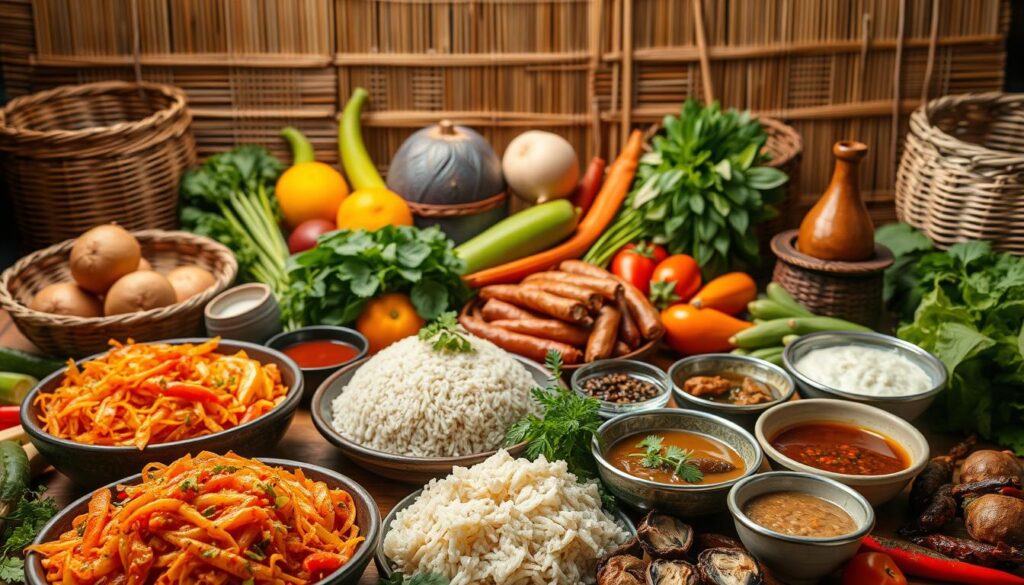
The Spicy Classics of Isan
Isan cuisine is famous for its spicy and sour tastes. Dishes like Som Tam (green papaya salad) and Larb (meat salad) are loved by locals and visitors. Trying these classics is a must to experience Isan’s bold flavours:
- Som Tam: A spicy and sour salad made from shredded green papaya, chilies, and peanuts.
- Larb: A meat salad flavoured with herbs, chilies, and lime juice, typically made with minced meat (chicken, beef, or pork).
- Gaeng Om: A spicy soup made with a variety of herbs and proteins.
Traditional Cooking Techniques
Traditional cooking in Isan focuses on grilling and BBQ, adding a smoky taste to dishes. Many of the region’s specialties are cooked over an open flame. This enhances the natural flavours of the ingredients. Common techniques include:
- Grilling over charcoal to infuse a smoky flavour.
- Using a mortar and pestle to prepare spices and herbs.
- Cooking with fresh ingredients to ensure the boldest flavours.
Exploring Isan’s culinary delights reveals more than just food. It shows the culture and tradition behind it. The bold flavours and spicy dishes reflect the region’s vibrant culture and people’s love for good food.
Central Thailand: Bangkok’s Culinary Hub
Exploring Bangkok reveals a lively street food scene. The air is filled with the scent of tasty dishes. You’ll find everything from spicy tom yum soup to sweet mango sticky rice.
Street Food Delights
Bangkok’s street food is a journey of delicious experiences. You can try traditional Thai dishes like pad thai and green curry. The city’s cultural diversity also brings international cuisine to the streets.
- Try the famous pad thai at one of the many street stalls.
- Sample the spicy and sour flavours of tom yum goong.
- Enjoy the city’s diverse international cuisine, from Chinese to Indian and beyond.
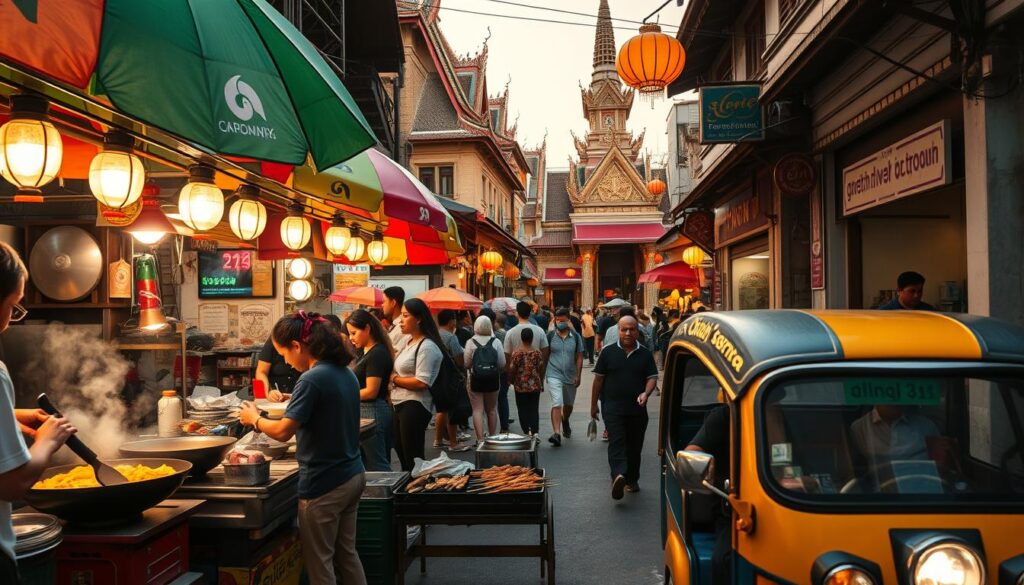
Must-Visit Markets for Authentic Flavours
Bangkok boasts some of the world’s most famous markets. These markets offer a unique sensory experience. They are perfect for trying authentic Thai dishes and drinks.
- Chatuchak Weekend Market: One of the largest markets in Asia, with over 15,000 stalls selling everything from clothing to street food.
- Damnoen Saduak Floating Market: A traditional floating market where vendors sell their goods from boats.
- Rot Fai Market: Known for its vintage shopping and street food, this market is a great place to experience Bangkok’s unique culture.
Visiting these markets is essential for experiencing Bangkok’s street food. Come hungry and ready to try new and exciting flavours.
Southern Thailand: Coastal Influences
Southern Thailand’s food is a lively mix of fresh seafood and rich curries. This area’s coastal setting gives its dishes a unique taste. You’ll find a special blend of flavors and ingredients here.
Curry Varieties from the South
The south of Thailand is known for its curry dishes. These curries are rich, slightly sweet, and creamy. They’re made with coconut milk.
Some popular curry types include:
- Massaman Curry: This curry is rich and has a sweet, spicy taste. It’s made with spices, potatoes, and peanuts.
- Panang Curry: It’s creamy and sweet, with a mix of spices and kaffir lime leaves. It’s often served with beef or chicken.
- Yellow Curry: Yellow curry is milder. It’s made with turmeric, coconut milk, and your choice of protein. It’s comforting and aromatic.
Fresh Seafood Specialties
Visiting Southern Thailand means trying its fresh seafood. The area’s long coastline offers a lot of seafood. It’s often grilled, steamed, or in salads.
Some dishes you must try are:
- Grilled Fish: Fresh fish, marinated in herbs and spices, is grilled to perfection.
- Seafood Salad: A spicy and sour salad with seafood, herbs, and lime juice. It’s refreshing and zesty.
- Steamed Mussels: Mussels are steamed in a flavorful broth. It’s tender and aromatic.
Exploring Southern Thailand’s food is like a journey through its culture and sea connection. You’ll find a variety of curries and fresh seafood. There’s something for everyone’s taste.
Thai Desserts: A Sweet Exploration
Thai desserts are a true reflection of Thailand’s rich culinary heritage. They use coconut milk, palm sugar, and local ingredients. As you try these sweet treats, you’ll find a mix of familiar and exotic flavours.
Classic Treats to Satisfy Your Sweet Tooth
Thai desserts offer a variety of classic treats. They are sure to satisfy your sweet tooth. Some must-try desserts include:
- Mango Sticky Rice: A classic dessert made with glutinous rice, fresh mango, and coconut milk.
- Tub Tim Krob: A refreshing water chestnut dessert served with crushed ice and a sweet coconut milk sauce.
- Khao Niew Mamuang: Another name for Mango Sticky Rice, highlighting the dish’s popularity.
These desserts are not only delicious but also show the simplicity and elegance of Thai cuisine.
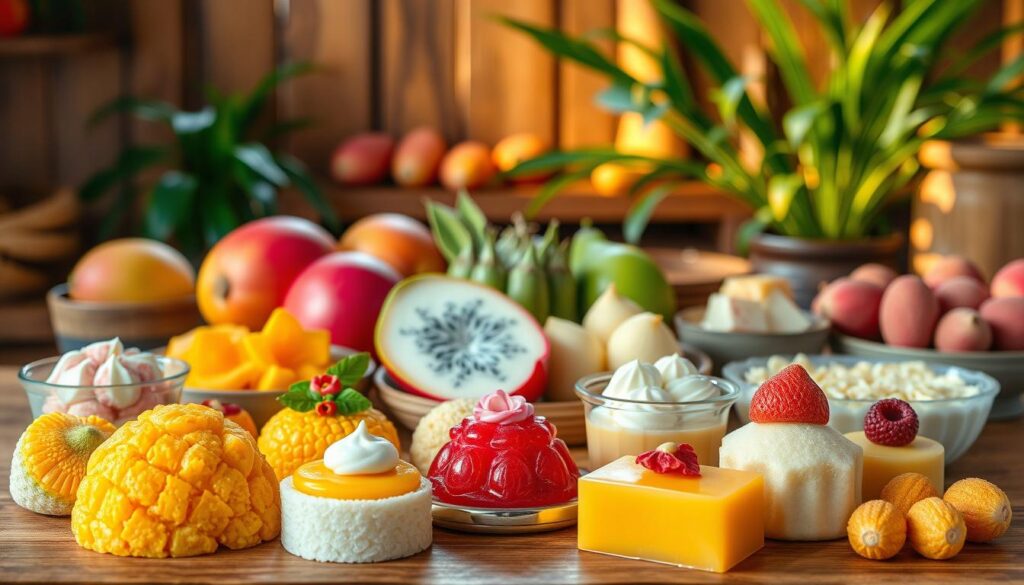
Unique Ingredients in Thai Desserts
The uniqueness of Thai desserts comes from their use of local and traditional ingredients. Some key ingredients include:
- Coconut Milk: Adds richness and creaminess to many Thai desserts.
- Palm Sugar: Provides a distinct flavour and aroma.
- Glutinous Rice: Used in desserts like Mango Sticky Rice, it’s a staple in Thai cuisine.
These ingredients, combined with the country’s culinary creativity, result in a diverse range of desserts. They are both traditional and innovative.
Exploring Thai desserts is a culinary adventure. It lets you experience the rich flavours and traditions of Thai cuisine. Whether you’re trying classic desserts or innovative creations, you’re sure to be delighted by the sweet world of Thai desserts.
The Role of Herbs and Spices in Thai Cooking
Exploring Thailand’s culinary world shows herbs and spices are key. Thai dishes are known for their bold, aromatic tastes. These come from fresh herbs and spices, adding depth and warmth.
Essential Thai Herbs to Know
Thai cooking uses many herbs for freshness, aroma, and flavour. Some top herbs include:
- Lemongrass: It has a citrusy taste and smell, found in many soups and curries.
- Galangal: Like ginger but stronger, it’s used in soups and curries for its unique taste.
- Thai Basil: Sweet and slightly spicy, it’s used in stir-fries and curries.
- Cilantro: Used as a garnish or mixed into dishes, it adds fresh flavour.
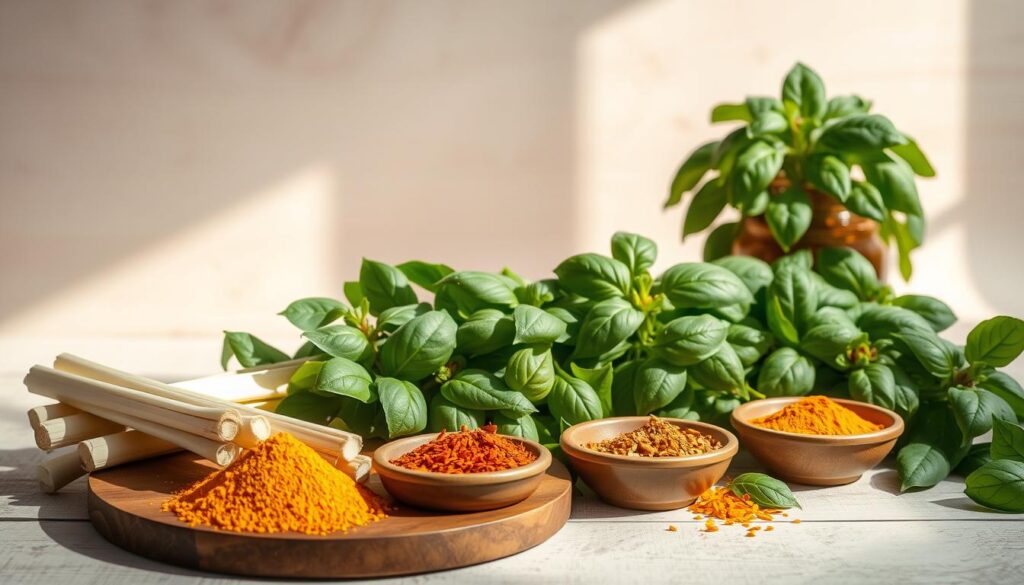
Spice Blends That Define Regional Flavours
Spice blends are vital in Thai cuisine, with each region having its own. Some notable ones are:
- Curry Pastes: A mix of spices, herbs, and sometimes shrimp paste, they’re the base of many curries.
- Chili Flakes: They add heat to dishes, used in many Thai recipes.
- Ground Spices: Spices like cumin, coriander, and turmeric add warmth and depth.
Learning about herbs and spices in Thai cooking deepens your appreciation. It lets you make authentic Thai dishes at home. Using these ingredients brings out the rich, diverse flavours of Thai cuisine.
Vegetarian and Vegan Options in Thai Cuisine
You don’t have to eat meat to enjoy Thai food. There are many plant-based dishes to try. Thai food is known for its variety, including options for vegetarians and vegans.
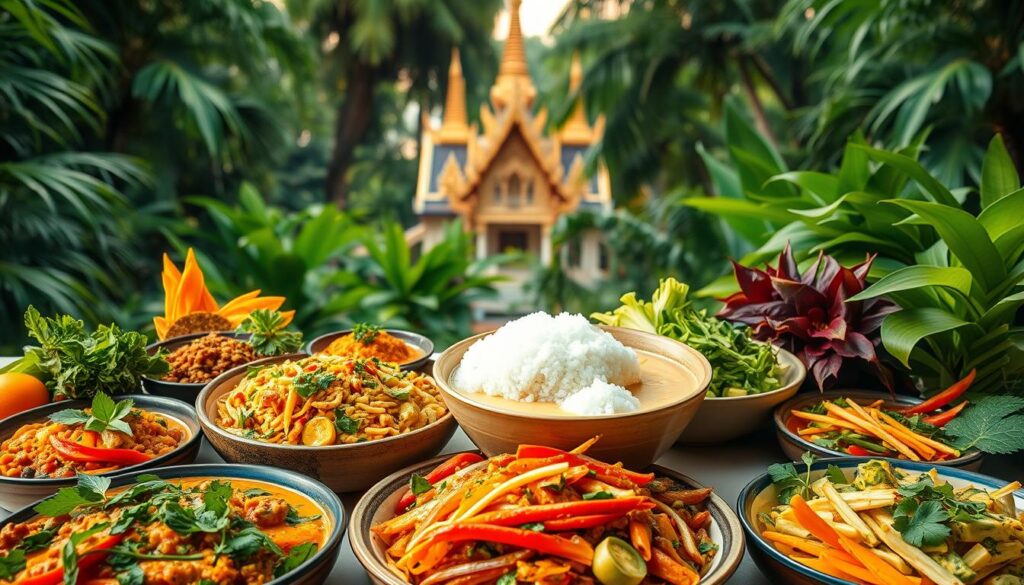
Popular Dishes for Plant-Based Diets
Thai cuisine has many dishes great for vegetarians and vegans. Pad Thai is a favourite that can be made without meat, using tofu. Som Tam, or green papaya salad, is often vegan-friendly.
Massaman curry is another option, made with vegetables or tofu and served with rice. You can also try Tom Yum soup without shrimp, Satay with tofu or vegetables, and stir-fries with local vegetables. These dishes are often free from animal products or can be easily adapted.
Tips on Finding Vegetarian Street Food
Finding vegetarian street food in Thailand is a fun experience. Look for stalls or markets with many vegetarian dishes. You can also ask vendors if they have vegetarian or vegan options.
- Opt for markets known for their vegetarian options.
- Check the ingredients if you’re unsure.
- Don’t hesitate to ask for modifications to suit your diet.
Being adventurous and open to new foods makes Thailand’s street food welcoming to vegetarians and vegans.
Thailand’s Culinary Festivals and Events
Thailand’s culinary culture is celebrated through many festivals and events. These events showcase the country’s diverse flavours. They are a great way to experience Thailand’s rich food heritage, with lots of dishes and drinks to try.

Major Food Festivals to Experience
Thailand has several major food festivals that draw visitors from all over. Some top events include:
- The Bangkok Food Festival, which highlights the city’s street food and modern Thai dishes.
- The Chiang Mai Food Festival, featuring the region’s unique dishes and cooking methods.
- The Phuket Food Festival, celebrating the island’s fresh seafood and Southern Thai flavours.
These festivals are a great chance to taste different regional delicacies. From spicy Isan dishes to sweet treats from Central Thailand, there’s something for everyone.
Local Events Celebrating Regional Specialties
Thailand also has local events that celebrate regional specialties. For instance:
- The Rocket Festival in Northeastern Thailand, where you can enjoy traditional Isan dishes.
- The Phi Ta Khon Ghost Festival in Dan Sai, Loei Province, featuring local delicacies and street food.
- The Hua Hin Jazz Festival, which combines music with a celebration of local cuisine.
Attending these events will deepen your understanding of Thai culinary culture. You’ll get to experience regional delicacies firsthand.
Tips for Visiting Culinary Festivals in Thailand
- Come hungry and be ready to try many dishes.
- Engage with local vendors and chefs to learn about ingredients and cooking techniques.
- Don’t be afraid to try new flavours and dishes – it’s all part of the culinary adventure!
How to Prepare Thai Dishes at Home
You can bring the flavours of Thailand into your kitchen with a few essential ingredients and some straightforward cooking techniques. Thai cuisine is known for its bold flavours and spices. But, it’s also surprisingly simple to prepare at home.
Thai cooking is all about simplicity and freshness. With a few key ingredients, such as fish sauce, lime juice, and chilies, you’ll be able to create a wide range of dishes. These dishes are both authentic and delicious.
Essential Ingredients You’ll Need
To start cooking Thai dishes at home, you’ll need to stock up on some essential ingredients. These include:
- Fish sauce: a salty, umami-rich condiment made from fermented fish.
- Lime juice: adds a sour and refreshing flavour to many Thai dishes.
- Chilies: bring the heat and add depth to your cooking.
- Coconut milk: used in many curries and desserts.
- Fresh herbs: such as basil, mint, and cilantro, add freshness and flavour.
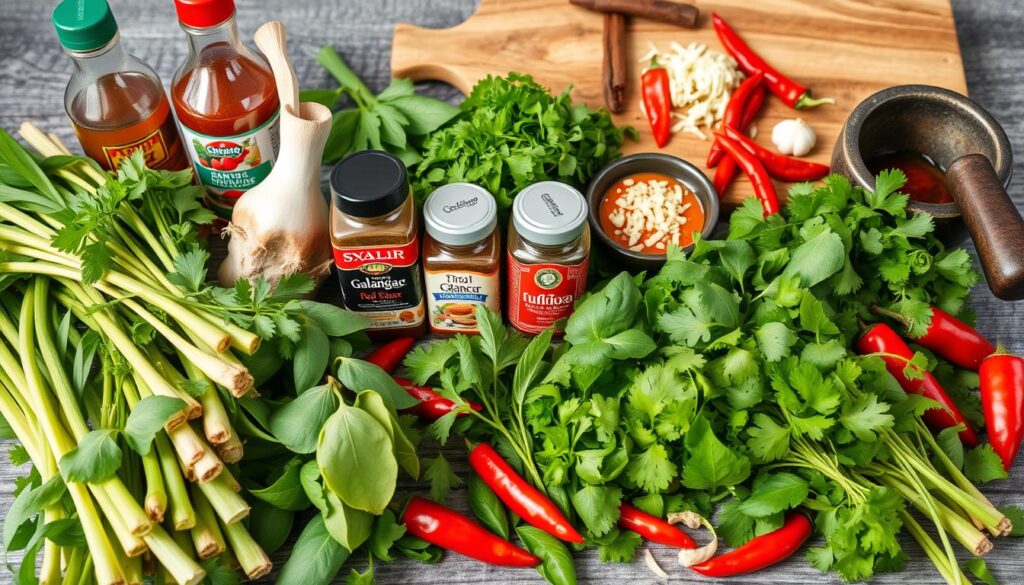
Simple Recipes for Beginners
Once you have the essential ingredients, you can start with simple recipes like Pad Thai and Tom Yum soup. These dishes are great for beginners. They require minimal ingredients and are quick to prepare.
For example, to make a basic Pad Thai, you’ll need rice noodles, vegetables, and your choice of protein (chicken, shrimp, or tofu). Cook everything in a wok with some oil. Season with tamarind paste, fish sauce, and palm sugar. Serve with peanuts and lime wedges on the side.
- Cook the rice noodles according to the package instructions.
- Heat some oil in a wok and add your choice of protein and vegetables.
- Add the cooked noodles to the wok, along with tamarind paste, fish sauce, and palm sugar, and stir-fry everything together.
- Serve hot, garnished with peanuts and a squeeze of lime juice.
Dining Etiquette in Thailand
Dining in Thailand is more than just eating. It’s a chance to experience the culture. Meals are often served family-style, showing respect and community.
What to Know Before You Sit Down to Eat
Before you eat, there are a few rules to follow. Wait for the host to invite you to sit. Also, wait for the eldest to start eating.
Using your right hand is polite, as the left is for personal hygiene.
Key dining etiquette tips include:
- Using your right hand when eating or passing dishes
- Waiting for the host or eldest person to start eating
- Not finishing a meal completely, as this implies the host did not provide enough food
- Not leaving your chopsticks standing upright in your rice, as this is reminiscent of a funeral ritual
Traditional Meal Practices
Thai meals are served family-style. Several dishes are placed in the center for everyone to share. This style promotes social interaction and community.
When dining with locals, you might use both utensils and hands. This shows respect for the Authentic Thai cuisine and Thai culinary culture.
Conclusion: Savoring the Flavours of Thailand
As you finish your food journey in Thailand, you’ll be inspired by its rich food culture. Thailand’s Regional Food is a world of bold tastes, spices, and special ingredients. It suits every taste and preference.
To keep enjoying Thai food, try new dishes at local markets or cook Thai recipes at home. From spicy Isan dishes to the curry-rich south, there’s always something new to try in Thai cuisine.
Exploring Further
Whether you love food or are just starting, Thailand’s regions have lots of exciting tastes to discover. Visit local markets, try street food, and try new ingredients. This will help you appreciate Thailand’s Regional Food more.
Continuing the Journey
Keep being adventurous and open to new things as you continue your food journey. Thailand’s rich culture and delicious food will make you want more of its Best Thai food experiences.

